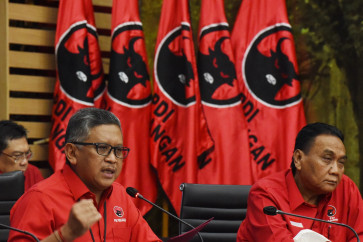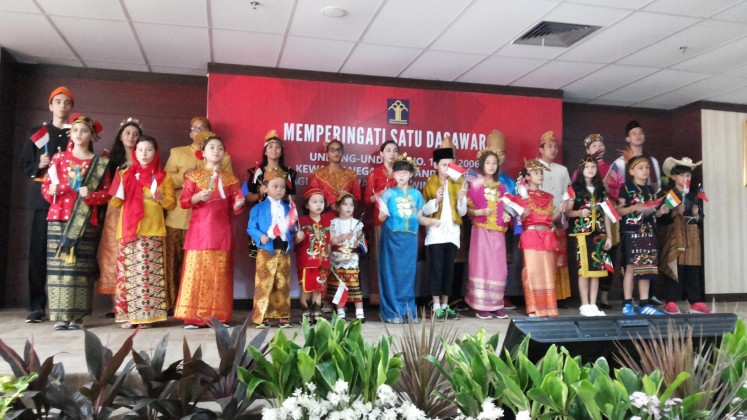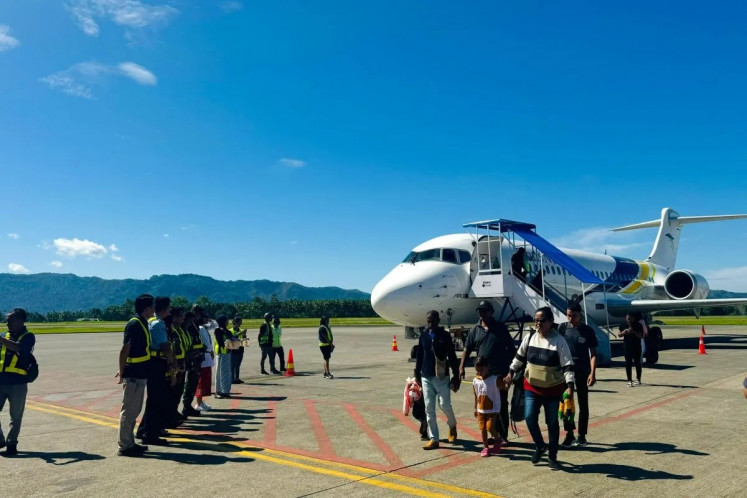Letting ‘keroncong’ flow
Opening: Pesinden Sruti Respati appears on the first day of the 2011 Solo Keroncong Festival in Ngarsopuro, Surakarta
Change Size

O
span class="inline inline-left">Opening: Pesinden Sruti Respati appears on the first day of the 2011 Solo Keroncong Festival in Ngarsopuro, Surakarta.Thousands of spectators crowded the 2011 Solo Keroncong Festival in Ngarsopuro, right in front of the Triwindu Market.
They were mesmerized as Endah Laras, a traditional singer from Surakarta, presented “Gemes” (Carried away), a song in the langgam or Javanese-style of keroncong, which is long known as Portuguese-tinged Indonesian music.
The song, written by Anjar Any and popularized in the 1970s by keroncong maestro Waldjinah, was jovially and temptingly sung by Endah that evening, testimony to the fact that keroncong is not always slow and soothing music.
Endah was not alone in adding color to keroncong during the festival. Earlier, the Zakaria Keroncong Orchestra offered a humorous piece entitled “Pakne Thole” (Boy’s dad). Presented in a duet, the old Javanese song triggered roars of laughter after being modified into an intensely expressive and almost theatrical composition for the stage, leading to calls to repeat the performance.
On the first day of the festival, Congrock from Semarang appeared with a blend of keroncong and rock music to suit the taste of the youth in the audience, making the show more attractive and less monotonous, while stirring the crowds to dancing and shouting. The notion that keroncong is for retirees was also dispelled as “Rumah Kita” (Our house), a song from the rock band God Bless, spurred people to sing along in the keroncong style and wave like rock music fans do at concerts.
“Through such music, we’re trying to offer and introduce keroncong to the younger generation. Keroncong will survive unless it’s monotonous, so there should be [new] creations. We can’t force today’s youth to enjoy keroncong in the style of olden times,” said Marco Manardi, Congrock’s leader.
For two nights the public welcomed the Solo Keroncong Festival with overwhelming enthusiasm. Many visitors were even prepared to sit in the road to watch the performances on two big screens set up on both sides of the stage. The throngs of onlookers in Ngarsopuro seemed untroubled by the suicide bombing that had recently shocked the city.
Opened by former transportation and manpower minister Erman Suparman, the second Solo Keroncong Festival had 18 keroncong groups from various regions as participants, including five foreign troupes from Italy, Hong Kong, Hungary, Malaysia and Singapore.
The event started with teenage keroncong musicians from the Putra Mawar Timur Solo Orchestra. Mostly junior high school students, they elegantly presented an instrumental medley that displayed their musical skills. The famous keroncong hits “Kota Solo” (Solo city), “Bengawan Solo” (Solo River) and “Tanah Air” (Motherland) marked the beginning of the international festival.
The Suara Banua Keroncong Ensemble from Banjarmasin, for instance, had three Malay songs including “Cindey” (Sash), which was once popularized by Malaysian pop diva Siti Nurhaliza. In its Malay keroncong version, “Cindey” sounded beautiful with violin enhancements slipping out to emerge between verses.
Two groups from Banyumas, Central Java, Nada Pertiwi (Purbalingga) and Citra Sudirman (Purwokerto), retained their thick regional accent and combined keroncong with traditional music dominated by cello-like instruments.
A singer from Hungary, Agnes Serfozo, was no less attractive. With the Bintang Surakarta Orchestra’s accompaniment, Agnes, who speaks fluent Javanese, sang “Putri Solo” (Lady of Solo) and “Pamit” (Taking leave) by noted composer Gesang. A pesinden (traditional Javanese singer) from Japan living in Solo for over a decade, Hiromi Kano, offered two versions of “Bengawan Solo”, in Javanese and Japanese.
Hong Kong’s James Chu was a magnet for his rendering of “Sewu Kutha” (Thousand cities) arranged in Javanese and Mandarin. He added color to the song through an amazing ukulele performance. The fourth child of Waldjinah, Bambang Herry, demonstrated his electric saxophone prowess through “Di Bawah Sinar Bulan Purnama” (Under the full moon’s light) and “Sarinah”, after pesinden Sruti Respati’s captivating “Pandanwangi” (Fragrant pandanus).
A classical singer from Italy, Max Valerio, had a duet with Waldjinah in “Semusim” (A season), a song she had sung with (the late) Chrisye a decade earlier. The duet this time made “Semusim” sound like an astonishing mantra with Max’s classical touch. Earlier, Max had presented “Indonesia Pusaka” (Indonesia the heritage) composed by Ismail Marzuki.
“Keroncong continues to exist among others due to such improvisations. I’m quite happy to see the young ones beginning to like
keroncong, though not necessarily in its original form,” said Waldjinah, who on the second day was awarded with a song titled “Ibu” from the D’Temasik Orchestra from Singapore for her dedication to the preservation of keroncong music.
“The times have changed so that keroncong modifications are legitimate. Those who like genuine keroncong can hold on to it, while those preferring modified keroncong can just go ahead,” said Surakarta musician and music observer Max Baihaqi.
The second day of the festival saw Waldjinah collaborating with Hudson Perananjaya, a singer emerging from the Indonesia Mencari Bakat talent scouting program. Hudson had a duet of “Gethuk” (Sweet potato snack) with Waldjinah, followed by a keroncong-styled “My Way” to wind up the festival, perfectly featuring the two characters he assumed.
“I’m proud to witness keroncong music spreading a long way off, with not only Indonesians but also foreigners capable of singing in this style. I wish keroncong would spread even further,” said Waldjinah at the end of the event.
— Photos By JP/Ganug Nugroho Adi









